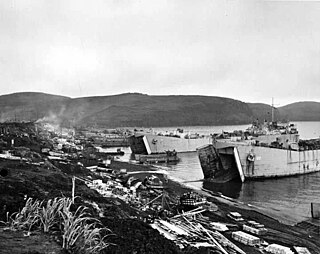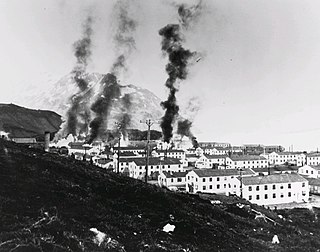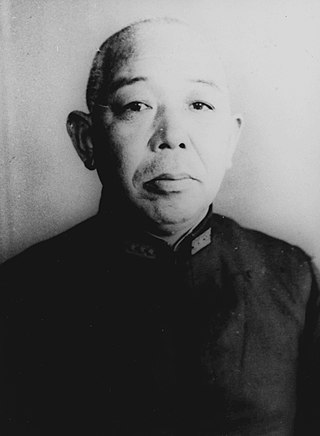
USS Grunion (SS-216) was a Gato-class submarine that sank at Kiska, Alaska, during World War II. She was the only ship of the United States Navy to be named for the grunion.

Kiska is one of the Rat Islands, a group of the Aleutian Islands of Alaska. It is about 22 miles (35 km) long and varies in width from 1.5 to 6 miles. It is part of Aleutian Islands Wilderness and as such, special permission is required to visit it. The island has no permanent population.
This is a list of aviation-related events from 1943:
This is a list of aviation-related events from 1942:

The Aleutian Islands campaign was a military campaign conducted by the United States, Canada, and Japan in the Aleutian Islands, part of the Territory of Alaska, in the American Theater and the Pacific Theater of World War II starting on June 3, 1942. In the only two invasions of the United States during the war of a U.S. incorporated territory, a small Japanese force occupied the islands of Attu and Kiska, where the remoteness of the islands and the challenges of weather and terrain delayed a larger American-Canadian force sent to eject them for nearly a year. Successful Japanese invasions of other U.S. territories, which were unincorporated territories, in the western Pacific shortly after the Attack on Pearl Harbor included Wake Island, Guam, and the Philippines. The islands' strategic value was their ability to control Pacific transportation routes as US General Billy Mitchell stated to the U.S. Congress in 1935, "I believe that in the future, whoever holds Alaska will hold the world. I think it is the most important strategic place in the world."

Operation Cottage was a tactical maneuver which completed the Aleutian Islands campaign. On August 15, 1943, Allied military forces landed on Kiska Island, which had been occupied by Japanese forces since June 1942. The Japanese, however, had secretly abandoned the island two weeks earlier, and so the Allied landings were unopposed. Allied forces suffered over 313 casualties in total during the operation, due to Japanese landmines and booby traps, friendly fire incidents, and vehicle accidents.

The Battle of Dutch Harbor took place on June 3–4, 1942, when the Imperial Japanese Navy launched two aircraft carrier raids on the Dutch Harbor Naval Operating Base and U.S. Army Fort Mears at Dutch Harbor on Amaknak Island, during the Aleutian Islands Campaign of World War II. The bombing marked the first aerial attack by an enemy on the continental United States, and was the second time in history that the continental U.S. was bombed by someone working for a foreign power, the first being the accidental bombing of Naco, Arizona in 1929.

The Battle of Attu, which took place on 11–30 May 1943, was a battle fought between forces of the United States, aided by Canadian reconnaissance and fighter-bomber support, and Japan on Attu Island off the coast of the Territory of Alaska as part of the Aleutian Islands Campaign during the American Theater and the Pacific Theater. Attu is the only land battle in which Japanese and American forces fought in snowy conditions, in contrast with the tropical climate in the rest of the Pacific. The more than two-week battle ended when most of the Japanese defenders were killed in brutal hand-to-hand combat after a final banzai charge broke through American lines.

The Japanese occupation of Kiska took place between 6 June 1942 and 28 July 1943 during the Aleutian Islands Campaign of the American Theater and the Pacific Theater of World War II. The Japanese occupied Kiska and nearby Attu Island in order to protect the northern flank of the Japanese Empire. Along with the Attu landing the next day, it was the first time that the United States was occupied by a foreign power since the War of 1812, and was one of the two invasions of the United States during World War II.
Sarana Bay is an inlet on the east coast of the island of Attu in the Aleutian Islands in Alaska. Hodikof Island is a small, 160 m long island in the bay. The seaward extension of Hodikof Island is known as Hodikof Reef.
Kiska Harbor is an inlet on the east coast of the island of Kiska in the Aleutian Islands in Alaska.
Amchitka Air Force Base is an abandoned Air Force Base located on Amchitka, in the Rat Islands group of the Aleutian Islands in southwest Alaska.

The Aleutian Islands, also called the Aleut Islands or Aleutic Islands and known before 1867 as the Catherine Archipelago, are a chain of 14 large volcanic islands and 55 smaller islands. Most of the Aleutian Islands belong to the U.S. state of Alaska, but some belong to the Russian federal subject of Kamchatka Krai. They form part of the Aleutian Arc in the Northern Pacific Ocean, occupying a land area of 6,821 sq mi (17,666 km2) and extending about 1,200 mi (1,900 km) westward from the Alaska Peninsula toward the Kamchatka Peninsula in Russia, and act as a border between the Bering Sea to the north and the Pacific Ocean to the south. Crossing longitude 180°, at which point east and west longitude end, the archipelago contains both the westernmost part of the United States by longitude and the easternmost by longitude. The westernmost U.S. island in real terms, however, is Attu Island, west of which runs the International Date Line. While nearly all the archipelago is part of Alaska and is usually considered as being in the "Alaskan Bush", at the extreme western end, the small, geologically related Commander Islands belong to Russia.

The military history of the Aleutian Islands began almost immediately following the purchase of Alaska from the Russian Empire by the United States in 1867. Prior to the early 20th century, the Aleutian Islands were essentially ignored by the United States Armed Forces, although the islands played a small role in the Bering Sea Arbitration when a number of British and American vessels were stationed at Unalaska to enforce the arbitrators' decision. By the early 20th century, a number of war strategies examined the possibility of conflict breaking out between the Empire of Japan and the United States. While the Aleutian Islands were seen as a potential staging point for invasions by either side, this possibility was dismissed owing to the islands' dismal climate. In 1922, the Washington Naval Treaty was signed, after which the United States Navy began to take an interest in the islands. However, nothing of significance was to materialize until World War II.

Shiro Kawase was a vice admiral in the Imperial Japanese Navy during World War II. He was a torpedo expert and his extensive experience as a commander of destroyers and destroyer formations made him more knowledgeable about the escort of convoys than most Japanese commanders of his time. He is best known for his command of the 5th Fleet during the latter stages of the Aleutians campaign in the spring and summer of 1943.

The landing at Amchitka was the amphibious landing operation and occupation of Amchitka island by American forces during the Aleutian Islands campaign.
Ro-65 was an Imperial Japanese Navy Type L submarine of the L4 subclass. First commissioned in 1926, she served in the waters of Japan prior to World War II. During World War II, she operated in the Central Pacific, supported Japanese forces in the Battle of Wake Island and invasion of Rabaul, and took part in the Aleutian Islands campaign. She sank in a diving accident in November 1942.











